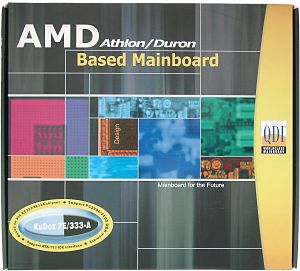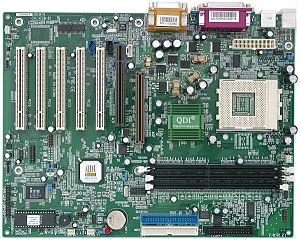QDI KuDoz 7E/333-A (VIA KT333) Mainboard
|

Products of this company are not widely spread, but at present
QDI carries out a policy of expansion. You can read more about the history of
the company, its development and peculiarities of production in our article on
Legend QDI.
Accessories:
- Package of a low-key but pleasant design;
- Documentation: a user manual in English;
- Cables: 1 ATA66/100/133 and 1 FDD;
- Bracket for the rear computer panel;
- CD with software including:
- drivers;
- user manual in PDF;
- Adobe Acrobat Reader;
- Norton Antivirus 2002;
- Q-Flash (for flashing BIOS from Windows);
- CBLogo (to add logos/images into the flash BIOS file, works under the DOS);
- DirectX 8.1.

The layout is typical and has some typical flaws: audio-ins are put
in between the PCI slots, and a power connector is between the rear panel's
unit and a processor's socket. It's not difficult to reach jumpers and
switches even when the board is already installed. Their functions are
shown on the textolite.
The 3-channel switching voltage regulator incorporates 7 capacitors
of 2200 uF.
The following controllers are integrated:
- audio controller based on the Avance Logic ALC650 AC'97 codec with a connector
for front audio-outs and supporting acoustic systems 5.1.
The board supports the following proprietary technologies: BIOS ProtectEasy
(for protection from recording into flash memory of the BIOS chip), LogoEasy
II (to display your own images during booting), RecoveryEasy II (for data
backup into a hidden area on the same hard drive), StepEasy II (to change
a processor's frequency from Windows) and BootEasy (for quicker booting)
- you can read more about some of these technologies in the article mentioned
above.
Non-unsoldered connectors: audio adapter based on the Creative CT5880.
The system monitoring is supported by the ITE IT8705F chip. What is
controlled:
- voltage of processor, +3.3, +5 and +/-12 V, VBAT and +5 B Standby;
- speed of 2 fans;
- temperatures of the processor (thermodiod in processor socket) and the board (a built-in
sensor).
There are 2 connectors for adjustable connection of fans and 1 for non-adjustable
connection.
Brief characteristics of the board: memory slots - 3 DDR SDRAM;
expansion slots - AGP/ 5 PCI/ ACR; I/O ports - 2 COM/ LPT/ 2 PS/2/ 4 USB
1.1; dimensions - 305x220 mm.
Adjustment can be carried out with:
| jumpers and switches |
Jumper to clear up the CMOS |
 |
| Jumper to choose a FSB frequency |
100/133 MHz |
| Switches to change a CPU multiplier |
Auto, x5-x12.5 |
| Jumpers to set processor voltage |
1.65-1.85 V in 0.025 V steps |
| Jumper to protect Flash EEPROM from writing |
 |
| Jumper to start up computer with a USB keyboard |
 |
| Jumper to start up computer with a PS/2 keyboard |
 |
| Jumper to enable/disable the audio codec |
 |
| BIOS based on the ver.6.00PG from Award |
Setup of memory timings |
+ |
CAS Latency, Bank Interleave, Precharge to Active, Active to
Precharge, Active to CMD, DRAM Queue Depth, DRAM Command Rate |
| Setup of memory frequency |
+ |
100, 133 and 166 MHz |
| Setup of AGP bus |
+ |
 |
| Setup of PCI bus |
+ |
 |
| Changeable scaler of AGP and PCI buses |
- |
 |
| Manual assignment of interrupts |
- |
 |
| Changeable FSB frequency |
+ |
100, 105, 110, 115, 120, 125, 133, 138, 142, 144, 150 and 154
MHz |
| Changeable CPU multiplier |
- |
 |
| Changeable core voltage |
- |
 |
| Changeable memory voltage |
- |
 |
| Changeable chipset voltage |
- |
 |
| Changeable AGP bus voltage |
- |
 |
We used the latest available version of the BIOS - 3.2.
This is an ordinary board without an extraordinary speed or capabilities
of precise adjustment or overclocking. The only pleasant thing is that
it supports the proprietary technologies.
Test results:
Write a comment below. No registration needed!
|
|
 |
|
|
|


